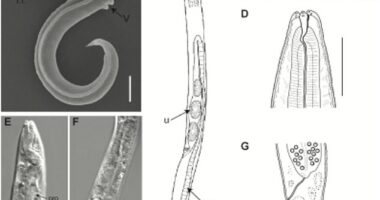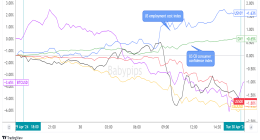
THE biggest asteroid to get close to Earth this year will fly by our planet today.
The space rock named 7335 (1989 JA) will soar within 2.5million miles of Earth at 29,000mph on May 27, according to Nasa.
According to Nasa’s close approaches database, the rock is up to 1.1 miles wide, which makes it four times bigger than the Empire State Building – or as tall as 350 giraffes stacked on top of each other.
Though it’s classified as “potentially hazardous” because it’ll come within 4.65 million miles of Earth, Asteroid 7335 does not pose any immediate threat to our planet.
The space object is expected to fly by on Friday at 10.26am EST, and budding astronomers can try and spot the asteroid a couple of days before with a backyard telescope, according to Earth Sky.
The asteroid should be reflecting sunlight on May 25, making it easier to spot as it appears like a slow-moving star.
You can watch the celestial event on the Virtual Telescope Project’s live stream, which will start on Thursday evening.
Read our Asteroid 7335 live blog for the latest news and updates…
-
Take a DART planetary defender quiz
Last year, Nasa’s Planetary Defense Coordination Office created a quiz for civilians and amateur astronomers to take part in the DART mission.
A quiz on the Nasa website asks five questions about asteroids, the redirection test, and the Planetary Defense Coordination Office.
Passing the quiz rewards users with a digital certificate and badge to share on social media.
You can support the DART mission by taking the quiz here.
-
The DART program explained
Nasa’s experimental anti-asteroid technology is titled the DART or Double Asteroid Redirection Test.
The DART spacecraft was built by the Johns Hopkins Applied Physics Lab in Maryland.
In order to change an asteroid’s path, the spacecraft impacts the object with great force.
-
The shape of asteroids, continued
Other considerations come into play when gravitational forces are absent.
Because asteroids collide, some become lumpier and less spherical, according to Space.com.
For example, the KBO Arrokoth is formed like two pancakes joined together.
Arrokoth is thought to have originated when two items gently twirled around one other, becoming closer and closer until they met and were locked together.
-
The shape of asteroids
An asteroid’s shape is affected by mass and gravity, according to Space.com.
Gravity draws everything evenly toward the body’s center of mass if a structure becomes large enough.
The spherical form is created by the gravitational pull.
The solar system’s asteroids, comets, and other tiny things, such as certain Kuiper Belt objects (KBOs), circle the sun beyond Neptune.
These objects are composed of leftovers from the creation of the solar system after the planets swept up most of the primordial material.
-
Asteroid crater in Greenland, part three
The researchers then used a laser to release argon and date the sedimentary material.
They ultimately discovered that the rocks from which the sand was generated had been dramatically damaged 58million years ago by studying the various isotopes of argon contained in their sample.
A far bigger asteroid slammed present-day Mexico eight million years ago, forcing the dinosaurs to become extinct.
The researchers next looked at the rate of uranium decay in the shocked zircon crystals to validate their findings.
-
Asteroid crater in Greenland, continued
Initially, charcoal particles obtained from glacial meltwater were thought to be generated from Pleistocene-era plant species.
Based on their findings, the researchers theorized that the Hiawatha crater originated roughly 13,000 years ago, perhaps sparking the Younger Dryas period of global cooling.
The so-called “younger Dryas cosmic impact” concept fit nicely with this scenario.
This is a contentious idea developed in 2007 that ties the return of glacial conditions over the globe, the loss of Pleistocene megafauna, and the extinction of the Clovis civilization in North America to an impactor hitting the Earth near the conclusion of the last Ice Age.
-
Asteroid crater in Greenland
A massive crater, which is more than thirty kilometers wide, was considered to be the consequence of an asteroid collision only a few thousand years ago.
According to recent research, the catastrophe occurred 58million years ago.
It’s around 500 meters deep beneath the Hiawatha Glacier in northwest Greenland.
It was discovered seven years ago by an ultra-wideband radar system created by the University of Kansas’ Center for Remote Ice Slab Sensing (CReSIS).
It measures around 31 kilometers in diameter and is thought to have been cut out by a ferrous asteroid.
-
Threatening space objects, continued
“We believe anything larger than one to two kilometers (one kilometer is a little more than one-half mile) could have worldwide effects,” Nasa’s site continued.
Just for reference, a standard 65 seat American school bus is about 35 feet long.
That means an asteroid smaller than a school bus could still be deadly depending on where it hit.
But for an asteroid to be “potentially hazardous,” it also has to meet other criteria.
-
Threatening space objects
Nasa’s website explains that when it comes to potentially dangerous asteroids, “Only once every few million years, an object large enough to threaten Earth’s civilization comes along.”
“Impact craters on Earth, the moon and other planetary bodies are evidence of these occurrences.”
“Space rocks smaller than about 25 meters (about 82 feet) will most likely burn up as they enter the Earth’s atmosphere and cause little or no damage.”
“If a rocky meteoroid larger than 25 meters but smaller than one kilometer ( a little more than 1/2 mile) were to hit Earth, it would likely cause local damage to the impact area.”
-
Infrared telescope to launch in 2026
NEO Surveyor, a space-based infrared telescope devoted to locating potentially deadly asteroids, will launch in 2026, thanks to funding from Congress in 2018.
-
Most destructive asteroid impact
A 6-mile (10-km) diameter asteroid collided with what is now the Yucatán Peninsula 65million years ago, causing the most renowned and deadly collision.
It wiped out the majority of Earth’s plant and animal species.
-
When is an asteroid a threat?
A near-Earth object is considered a hazard by astronomers if it comes within 4.6million miles (7.4million kilometers) of the planet and has a diameter of at least 460 feet (140 meters), according to The Conversation.
If a celestial body of this magnitude collided with Earth, it might wipe out whole cities and devastate entire regions.
Larger objects, such as those measuring 0.6 miles (1 km) or more, might have global consequences and perhaps result in mass extinctions.
-
What is the current asteroid count?
According to NASA, the current known asteroid count is 1,113,527.
-
Nasa’s ‘eyes on asteroids’
Nasa’s website has an interactive page called “eyes on asteroids” where you can see the next few closest approaches of asteroids to Earth.
As of the afternoon of May 13, it lists Asteroid 388945 (2008 TZ3) as one of the next five closest approaches to Earth.
It says it should pass Earth around 5.18pm ET on May 15.
-
NEO mission
Nasa is hoping to launch its Near-Earth Object (NEO) Surveyor mission in 2026.
If the agency does so, it will finally have a spacecraft dedicated only to hunting asteroids.
It’s hoped that the NEO Surveyor craft will find 90 percent of asteroids that are 460 feet or larger within the first decade of its mission.
-
Youngest asteroids ever found in Solar System
Researchers have found a pair of asteroids orbiting the Sun that were formed under 300 years ago.
Details of the Astronomical discovery were published in a report in the Monthly Notices of the Royal Astronomical Society.
The twin asteroids – dubbed 2019 PR2 and 2019 QR6 – are the youngest found in our solar system.
“It’s very exciting to find such a young asteroid pair that was formed only about 300 years ago, which was like this morning – not even yesterday – in astronomical timescales,” astronomer Petr Fatka of the Astronomical Institute of the Czech Academy of Sciences said.
-
What is the temperature of an asteroid?
According to Space.com, the average temperature of an asteroid’s surface is minus 100 degrees Fahrenheit.
-
What is a NEO?
Nasa considers anything passing near Earth’s orbit a Near-Earth Object (NEO).
Thousands of NEOs are tracked by scientists to monitor whether they’re on a collision course with our planet.
-
How do asteroids get their names?
When it comes to naming asteroids, the International Astronomical Union’s Committee on Small Body Nomenclature is lenient.
As a result, there’s a massive space rock named Mr Spock circling the Sun after the Star Trek figure.
There is also another space rock named after rock musician Frank Zappa.
There are even more solemn memorials, like the seven asteroids named after the crew of the Space Shuttle Columbia, which perished in 2003.
Asteroids are also given names based on places and other things, according to NASA.
-
Did an asteroid kill the dinosaurs?
The extinction of the dinosaurs was definitely caused by an asteroid impact, according to a team of scientists who were evaluating whether the newer theory that volcanoes led to their demise was accurate.
The researchers used a variety of methods to assess ancient temperature records and the amount of greenhouse gases that could have been in the atmosphere.
According to the study results, volcanic gasses may have still played a role in the decline of the dinosaurs.
-
Close approaches, according to NASA
Hundreds of NEAs pass within 0.05 au of Earth every month.
NASA has made a table public to show a summary of these upcoming and recent near approaches, along with information on the encounter circumstances.
The greatest brightness obtained by the object during close approach is one of the table’s values, which may be used to assess its observability during the encounter.
The maximum brightness value is increased by 100 when the encounter occurs in daylight to emphasize that the geometry is unfavorable for observations.
-
What is a ‘potentially hazardous’ asteroid, continued
An asteroid would also need to be 460 feet or larger in size to be considered potentially hazardous by Nasa.
Thousands of near-earth objects (NEOs) are tracked by scientists to monitor whether they’re on a collision course with our planet.
Nasa lists them in its NEO Earth Close Approaches table.
-
What is a ‘potentially hazardous’ asteroid?
Nasa’s Center for Near-Earth Object Studies (CNEOS) explains on its website: “Potentially Hazardous Asteroids (PHAs) are currently defined based on parameters that measure the asteroid’s potential to make threatening close approaches to the Earth.”
Large fast-moving space objects that come within 4.65 million miles of Earth are considered to be “potentially hazardous” by cautious space organizations.
One small change to their trajectories could spell disaster for Earth.
-
When was Asteroid 7335 first observed?
The initial observation was made in April 1989 at the finding observatory, extending the asteroid’s observation arc by one month previous to its discovery, per MinorPlanetCenter.net.
-
What type of asteroid is 7335?
Asteroid 7335 is an S-type asteroid, which circles the Sun every two years and four months at a distance of 0.9–2.6 AU, per LiveScience.









